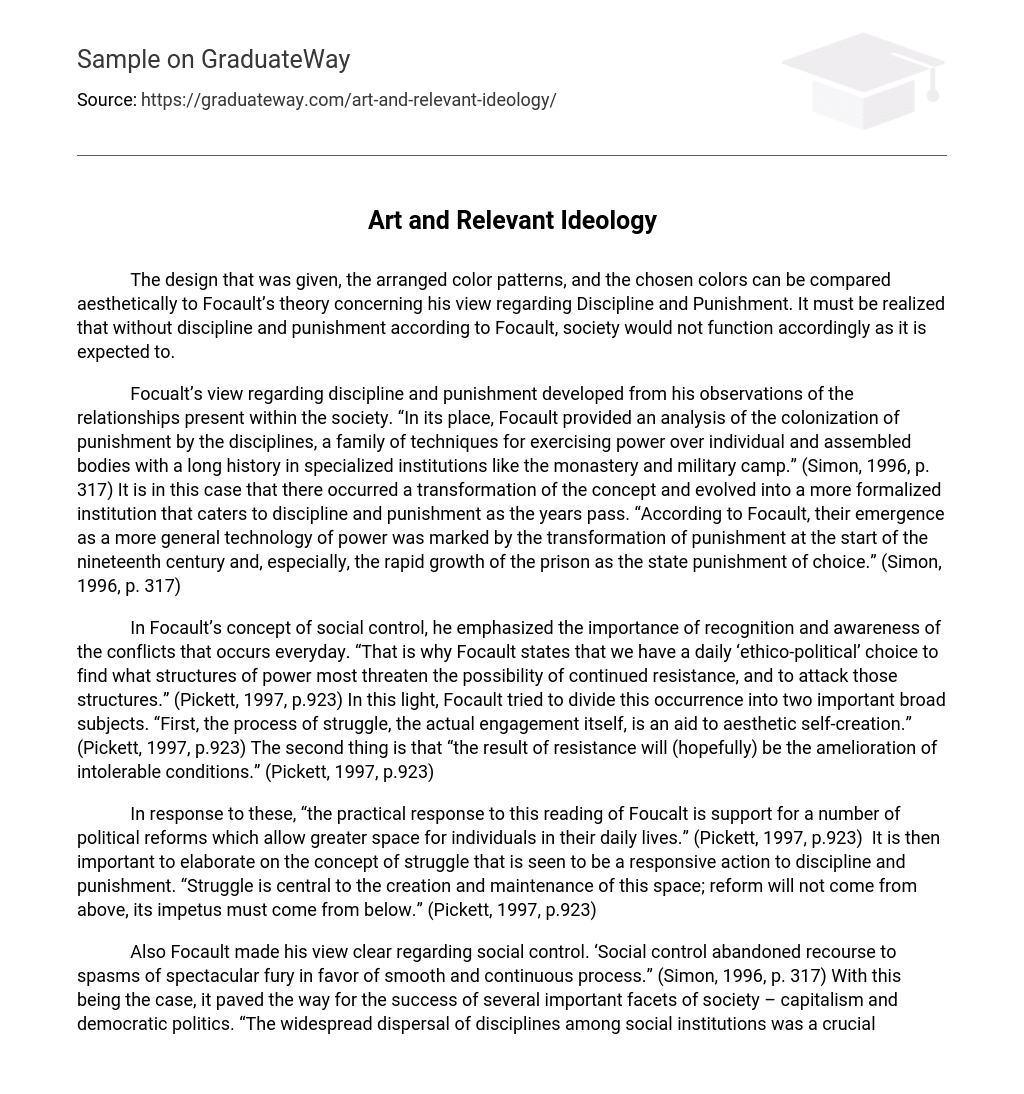The design that was given, the arranged color patterns, and the chosen colors can be compared aesthetically to Focault’s theory concerning his view regarding Discipline and Punishment. It must be realized that without discipline and punishment according to Focault, society would not function accordingly as it is expected to.
Focualt’s view regarding discipline and punishment developed from his observations of the relationships present within the society. “In its place, Focault provided an analysis of the colonization of punishment by the disciplines, a family of techniques for exercising power over individual and assembled bodies with a long history in specialized institutions like the monastery and military camp.” (Simon, 1996, p. 317) It is in this case that there occurred a transformation of the concept and evolved into a more formalized institution that caters to discipline and punishment as the years pass. “According to Focault, their emergence as a more general technology of power was marked by the transformation of punishment at the start of the nineteenth century and, especially, the rapid growth of the prison as the state punishment of choice.” (Simon, 1996, p. 317)
In Focault’s concept of social control, he emphasized the importance of recognition and awareness of the conflicts that occurs everyday. “That is why Focault states that we have a daily ‘ethico-political’ choice to find what structures of power most threaten the possibility of continued resistance, and to attack those structures.” (Pickett, 1997, p.923) In this light, Focault tried to divide this occurrence into two important broad subjects. “First, the process of struggle, the actual engagement itself, is an aid to aesthetic self-creation.” (Pickett, 1997, p.923) The second thing is that “the result of resistance will (hopefully) be the amelioration of intolerable conditions.” (Pickett, 1997, p.923)
In response to these, “the practical response to this reading of Foucalt is support for a number of political reforms which allow greater space for individuals in their daily lives.” (Pickett, 1997, p.923) It is then important to elaborate on the concept of struggle that is seen to be a responsive action to discipline and punishment. “Struggle is central to the creation and maintenance of this space; reform will not come from above, its impetus must come from below.” (Pickett, 1997, p.923)
Also Focault made his view clear regarding social control. ‘Social control abandoned recourse to spasms of spectacular fury in favor of smooth and continuous process.” (Simon, 1996, p. 317) With this being the case, it paved the way for the success of several important facets of society – capitalism and democratic politics. “The widespread dispersal of disciplines among social institutions was a crucial ingredient, according to Focault in the takeoff of modern industrial capitalism and democratic politics.’ (Simon, 1996, p. 317)
In Focault’s work, he focused on three important categories of his study. (1) “Focualt focused for the most part of the last portion of the eighteenth century and the first half of the nineteenth, yet few who read the book missed the salience of the present.” (Simon, 1996, p. 317), (2) “away from a view of the prison as an ideological system operating primarily through representation on the individual and collective imagination and toward a view of the prison as a surface for the effective exercise of power over individual bodies and groups.” (Simon, 1996, p. 317), Lastly, (3) “away from assuming a central role for the state as the key actor in the evolution of punishment and toward a focus on technologies of power developed in state and non-state settings and circulating among them.” (Simon, 1996, p. 317)
The main theme of the work is that it promotes discipline and order. The varieties of colors are patterned into a sequence that adheres to the overall perception of the visual. The overlapping of circles represents the punishment due to non-compliance. The circles overlapping the other also represent the capability of each one to suppress the covered ones to prevent from standing out. It is in this idea that struggle must again be suppressed according to Focault. This can be done by the proper mechanisms and procedures in implementing and incorporating discipline and punishment into the system.
The arrangement of colors in the artwork follows a certain color scheme. It tends to match with each other. It is as if it follows a specific order – a guideline that the creator followed. Also, looking closely at the artwork, the edges of the circles are arranged in such a way that it does not form a perfect a perfect circle. Blotches can be seen in the picture. This somehow defeats the purpose of perfection. With non-compliance to several facets and measurement, a work can be deemed beautiful to the aesthetic eye.
Analyzing deeper, it can be seen that the yellow circles represent our own individual society. These are societies that we grew accustomed to. The violet-patterned circles represent the actual rules and regulations that society imposes on us. The ability to of society to dictate and demand its citizens on what to do clearly exemplifies Focault’s principles regarding discipline and punishment.
References
Pickett, B. (1997) Focultian Masks and Contested Interpretations in Political Research
Quarterly. 50 no. 4 Retrieved October 21, 2007 from http://links.jstor.org/sici?sici=1065-
9129%28199712%2950%3A4%3C919%3AFMACI%3E2.0.CO%3B2-5
Simon, J. (1996) Discipline and Punish: The Birth of a Middle-Range Research Strategy in
Contemporary Sociology. 25 no. 3 Retrieved October 21, 2007 from http://links.jstor.org/sici?sici=0094-3061%28199605%2925%3A3%3C316%3ADAPTBO%3E2.0.CO%3B2-G





